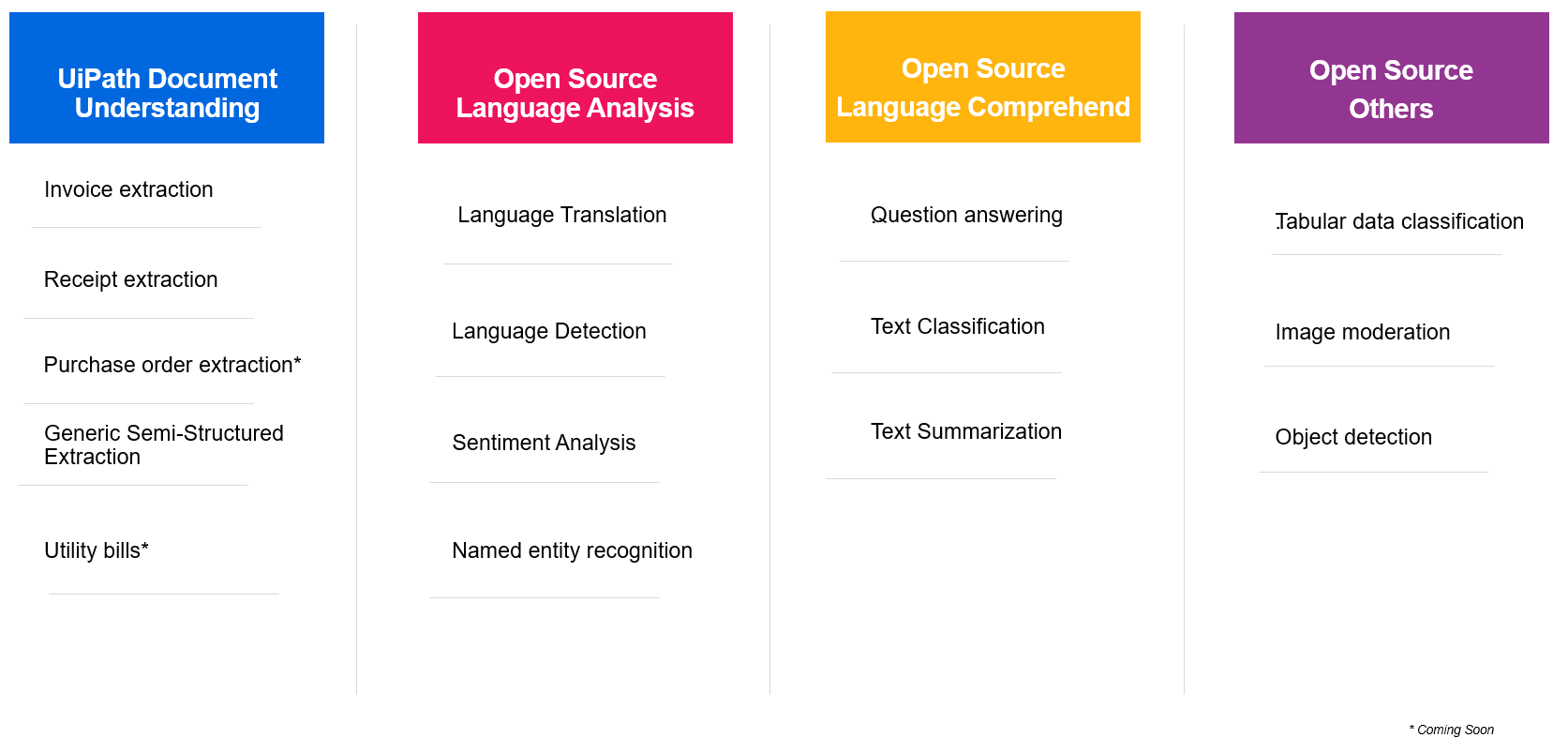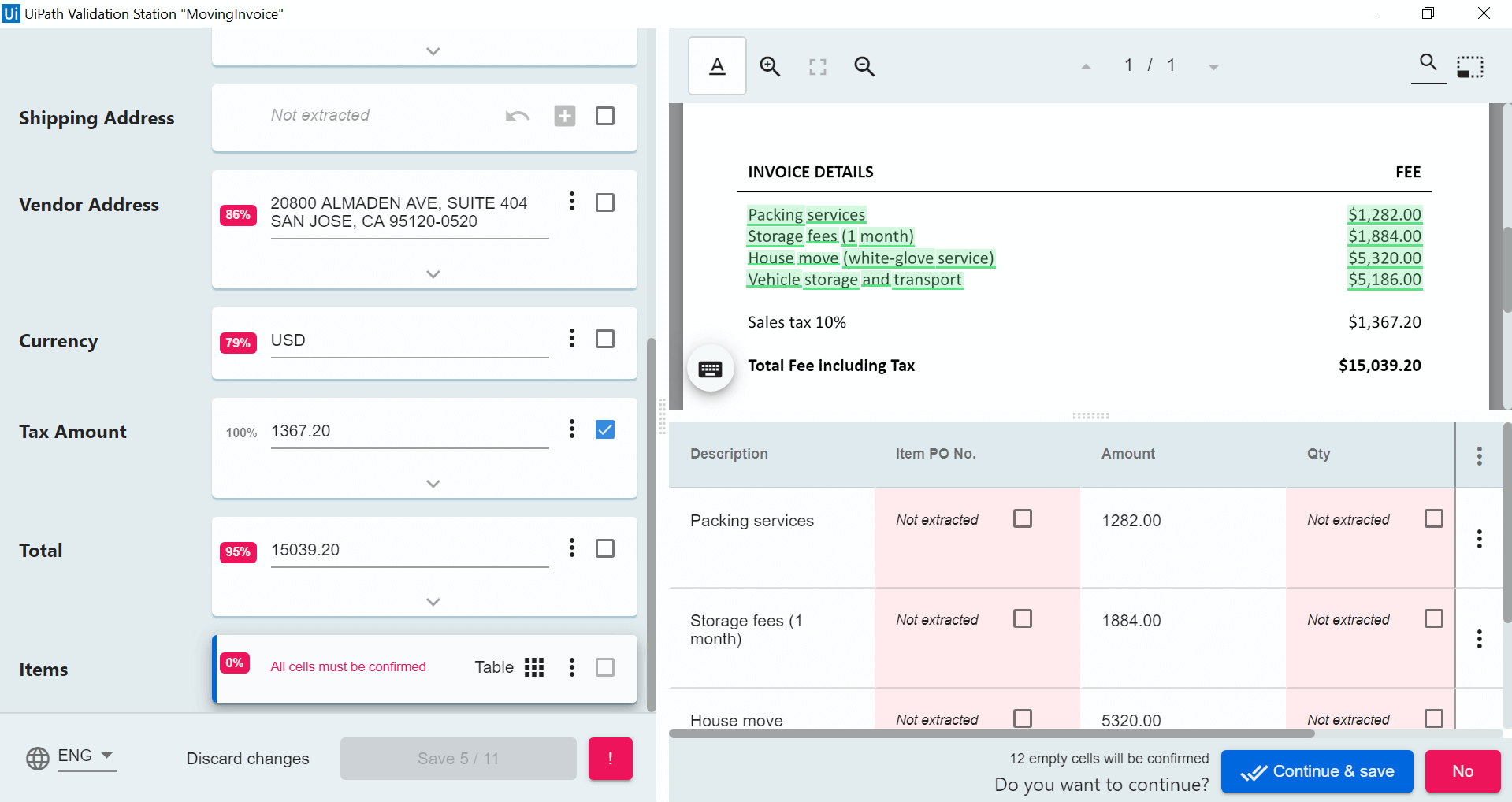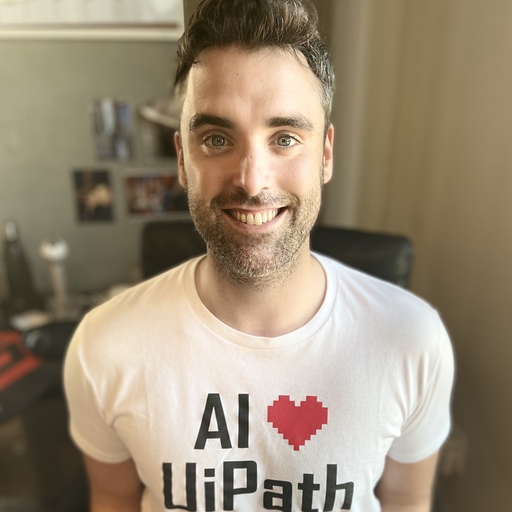AI Just Got Easier: UiPath Starter Models to Automate More Complex Processes
Share at:

Editor's note: As the automation market continues to evolve, the UiPath Platform also updates to best serve the automation needs of our customers. As such, some of the product names in this article have evolved since the article was originally published. For up-to-date information, please visit our AI Center page.
There's also still time to save your seat at the upcoming UiPath AI Summit.
Ninety percent of an organization’s data is unstructured—images, videos, text, PDFs, handwritten documents, and so on. This means it is very difficult to use this data to make smart business decisions, or to do so in a timely manner.
In some occasions, time saves lives. With UiPath AI Fabric and UiPath Document Understanding, a clinic quickly processes patient data, predicts high-risk pregnancy rates, and enrolls patients to appropriate programs, avoiding 44% of low birth-weight pregnancies. The clinic is able to help their patients in a more timely manner while also saving $11 million annually.
The above process would have been impossible without artificial intelligence (AI). AI is a concept that describes machines as a technology to execute tasks which usually require human intelligence. It includes machine learning (ML), computer vision, chatbots, and natural language processing (NLP).
While AI has become a shorthand for a range of big data, statistical, and predictive techniques, UiPath focuses on “practical AI,” applying AI in tangible scenarios that improve automation outcomes. We’ve built AI into every part of the UiPath Platform, from detecting objects using computer vision, to discovering automation opportunities, and managing and scaling AI. In turn, businesses are moving from simpler automation scenarios to more complex ones, which involve unstructured data, lots of variables, and uncertain outcomes.
What’s more, UiPath makes it easy for RPA developers and Centers of Excellence (CoEs) to start with our out-of-the-box models, customize based on their own data, and then retrain them. No extensive data science background needed!

An in-depth example: Bring structure to your unstructured data
Let’s take a more in-depth look at another example. To review a loan application via the Paycheck Protection Program, banks need to verify that all information has been properly completed, that the form has been signed and dated, and then review supplementary information such as 1099 IRS forms, tax return information, and payroll information. These documents are generally scanned images, some of them filled out by hand, and submitted in different ways.
So, how can AI help automate this process? AI can be used to digitize each document, transforming each document from an image to machine-readable text through optical character recognition (OCR) technology. Advanced OCR engines can even read handwritten text while ignoring extraneous marks, corrections, or crossed out items.
Once the document becomes machine readable, AI can be used to identify and sort each document, distinguishing between an application form, an IRS form, a tax return, or payroll information. Then, for each of these documents, AI can be used to extract the relevant information in a payroll document or other documents, regardless of how the information is placed on the page.
Once the key loan information is extracted and converted to a structured format, AI can be used to automatically flag errors or anomalies – all of which can reduce the burden on overworked loan approvers. This type of end-to-end automation would not be possible with traditional methods but AI expands automation potential.
By bringing structure to unstructured data, AI and ML models unlock the true value of data and enable companies to build predictive models that will help them make smarter, faster, and better decisions. This becomes possible owing to UiPath Document Understanding and UiPath AI Fabric – cutting-edge technologies offered by UiPath for automating highly –manual, complex processes.
Different approaches of getting machine learning models
Both the above two examples use ML models. ML models are pieces of software that have been trained to solve a specific problem by being exposed to large sets of data.
There are different approaches, but generally, ML models learn patterns and rules by analyzing data, often without being directed by programmers on what to look for. ML models can thus find ways to solve a program on a massive scale, and in a way that may be different than if a human were to explicitly program it to solve a problem based on a set number of rules.
There are multiple ways for companies to access and make use of ML models. Companies with data scientists and large data sets often train their own ML models tailor fit for their needs. Think of Netflix creating content recommendation models and customer micro-segmentation, all powered by ML models trained on their users’ activity.
Other companies may start with open-source models or utilize pre-trained models developed by software vendors or system integrators. These methods can provide valuable acceleration, particularly when the company does not have the scale of data needed to train their own model, or if a problem is already well-solved with industry best solutions available publicly, e.g., Stanford NLP.
Moreover, you can train your own ML model on top of the pre-trained models provided by different vendors. This will save time spent on building a model from scratch and you don’t necessarily need a data scientist to retrain such a model.
You don’t need to be a data scientist to use ML models
UiPath makes it easy for RPA developers and business users to benefit from AI and ML models without deep data science expertise through products such as UiPath AI Fabric and UiPath Document Understanding.
UiPath AI Fabric is an AI platform (part of the end-to-end automation solution provided by the UiPath Platform) enabling companies to easily deploy, manage and improve their ML models. AI Fabric provides many out of the box pre-trained models, or customers can upload their own internally developed ML models – enabling easy operationalization of internal ML models without the need to rewrite the models to be consumable in RPA.

UiPath Document Understanding helps computers understand and extract data from documents, including unstructured data. It can digitize, classify, extract, and export data for further processing within end-to-end automation workflows. Optional human validation is another important step serving not just as a way to confirm or correct the output, but also to retrain the model based on the custom data.

Document Understanding and AI Fabric work together by enabling AI capabilities to be easily exposed via document workflows. For example, UiPath Document Understanding offers pre-trained document processing models that are hosted in AI Fabric. Customers can use these ML models as-is or choose to use these models as a starting point and then further customize them for their own business needs.
AI Fabric also pre-packages open-source models, enabling them to work in conjunction with Document Understanding. For instance, suppose the borrower in the previous example submitted a letter with additional information explaining discrepancies between the application form and some supporting documents. Document Understanding can extract the text out of this scanned letter, AI Fabric can then detect the language, then apply named entity recognition to extract the relevant information, and potentially even summarize the key points of the letter. A full list of out-of-the box models are listed below.

Customize ML models without needing a data science background
Of course, the pre-trained, out-of-the-box models from UiPath AI Fabric are just the beginning. Most customers will elect to take the pre-trained models as the starting point and then apply further customization to meet their business objectives. Model retraining can enable customers to extend the model beyond its original design as well as to achieve even higher accuracy for each customer’s specific data set.
Take, for example, a recent UiPath customer example – this customer wanted to automate an invoice process but needed one additional bill of lading field that is not available in the pre-trained Document Understanding Invoice model. Failing to extract this field would mean that every invoice document would require a human touch. However, with the retraining capabilities built into AI Fabric, this customer was able to apply transfer learning from the UiPath pre-trained model to reduce their data needs, resulting in a customized ML model with greater than 95% accuracy.
In the upcoming releases, UiPath will also upgrade the human validation capabilities within Document Understanding. To make custom ML model retraining even faster and easier, all data confirmed and corrected by a human will be automatically used for model retraining. Thus, the more you work with the model, the more trained and accurate it will become in processing your documents.

In both cases, the models can be done without data scientists. With AI Fabric and Document Understanding, ML model retraining has been democratized for non-data scientists, enabling RPA developers and business users with domain-specific knowledge to easily mark up samples. Then they can use AI Fabric to retrain the model without needing to understand or think about feature engineering, hyperparameterization, or any other data scientist-specific knowledge.
Ecosystem ML models from our technical partners
Beyond the pre-trained models made available out of the box from AI Fabric and Document Understanding, UiPath has a robust Marketplace with a wide range of reusable RPA components from technical partners or individual contributors. These capabilities are easily searchable and can be added directly to UiPath RPA workflows, enabling easy integration beyond capabilities developed directly by UiPath.
Worrying about how many data scientists you need to use and train an ML model for your business? With UiPath, you don’t necessarily need one to get started.
As you can see, whether you use just UiPath Document Understanding models for document processing, or extend your automation scenarios with UiPath AI Fabric, it’s easy to apply AI even for business users or RPA developers. You can use the starter models and try both products for free within UiPath Automation Cloud for enterprise trial and start automating complex business processes right now.
This blog post was co-authored by Tony Tzeng. Tzeng is the Director of AI Product Management for UiPath Document Understanding at UiPath.

Director Product Management Machine Learning, UiPath
Get articles from automation experts in your inbox
SubscribeGet articles from automation experts in your inbox
Sign up today and we'll email you the newest articles every week.
Thank you for subscribing!
Thank you for subscribing! Each week, we'll send the best automation blog posts straight to your inbox.



